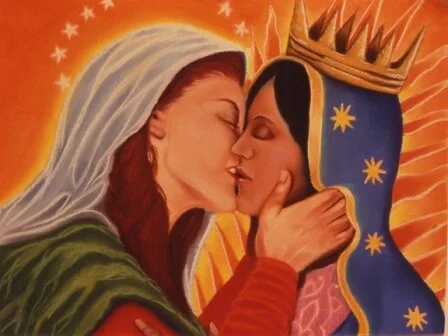
While googling some of Alma Lopez’s pieces, I came across this picture of Mary Magdalene and the Virgin of Guadalupe kissing which sparked my interest. This piece is by Alex Donis, a Guatemalan queer artist from Los Angeles.
While Donis grew up Catholic, he always resented the Church’s homophobic tendencies. His lived experiences inspired him to create a space to manifest what usually gets seen as forbidden or ‘dangerous’ desires. It is through his art that he succeeds in creating these spaces that would otherwise get displaced and ignored by the public sphere.
Like Alma Lopez, Donis’ piece, Mary Magdalene and The Virgin of Guadalupe from his My Cathedral collection, uses alternative modes of cultural production to create a space for queer desire and sexuality. Like Alma, Donis also uses symbols, in this case two biblical women who would normally be seen as opposites; one representing virginity and purity, while the other symbolizes sexual impurity. By using these clashing symbols, Donis challenges the taboo of sexuality as presented by the Church and hopes to invoke in all a desire to dig deep into one’s own sexuality and desire.
Overall, Donis and other artists that we have learned about in class search to break paradigms that are hierarchical and repressive through different art forms.
–Sandy Garcia


